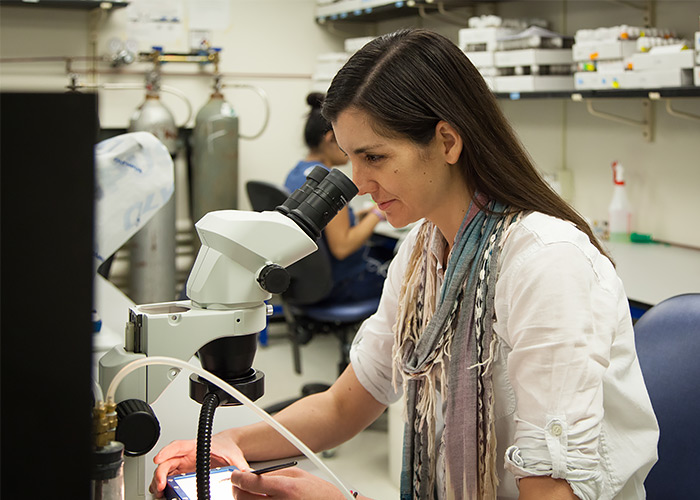Experiment Will Recreate Evolutionary Transition in Drosophila
Lurking in our genome are fragments of DNA capable of jumping from one place to another.

Kelleher, assistant professor of biology and biochemistry, studies how genomes maintain
stability through the evolution of regulatory mechanisms that control the activity
of jumping genes.These “jumping genes,” formally referred to as transposons or transposable elements,
were first discovered by the geneticist Barbara McClintock, who won the 1983 Nobel
Prize in Physiology and Medicine for her discoveries.
Erin Kelleher, assistant professor of biology and biochemistry in the University of Houston’s College of Natural Sciences and Mathematics, is studying how genomes maintain stability through the evolution of mechanisms that regulate the activity of these jumping genes.
Our Genome: The Blueprint for Our Bodies
Our genome can be thought of as the blueprint for our entire body, containing all of the instructions necessary to build and maintain our bodies. It is passed from parent to offspring.
Jumping genes can hop from the genome of one species to another. Once within a particular genome, jumping genes can also move from one spot in the genome to another. This activity threatens the stability of this blueprint. These jumping genes can be thought of as parasites, living and reproducing within the host genome without offering benefits.
“The big question that my lab is addressing is: How do genomes evolve ways of repressing non-native transposable element activity?” Kelleher said.
Jumping Genes Threaten To Disrupt Blueprint
Jumping genes can drive evolution by expanding, rearranging and modifying the genome. However, jumping genes also can also mutate, disrupt and disorganize, leading to effects such as sterility and the onset and progression of multiple cancers.
To counteract this threat, genomes have evolved mechanisms of regulating jumping gene activity. One of these mechanisms is the piRNA pathway, which plays a role in making sure these jumping genes don’t damage the genome by moving around.
“I am interested in how these genomic parasites and their host genomes influence each other over evolutionary time. The transposable elements are part of the genome, yet they don’t always get along with their host. What we’re observing is the arbitration of their disagreement,” Kelleher said.
To understand how genomes evolve to repress activity of these transposable elements, Kelleher is looking at a specific jumping gene, called the P-element, which hopped from one species of fruit fly to another.
P-Element: Jumped From One Fly Species to Another
The transfer of P-element from one species of fruit fly to another, known as a horizontal transfer event, is thought to have begun with mites feeding on Drosophila willistoni eggs. While feeding, the mites probably ingested fragments of DNA and then fed on Drosophila melanogaster eggs, with P-elements coming along for the ride. P-elements became widespread in wild populations of Drosophila melanogaster in the 1950s.
Once in Drosophila melanogaster, P-elements are capable of jumping from one spot in the genome to another, disrupting and rearranging along the way.
“In a short evolutionary timescale, Drosophila melanogaster has evolved strong regulatory mechanisms that keep P-elements from disrupting the genome. This evolutionary transition is what we are trying to understand,” Kelleher said.
Recreating the P-Element Invasion in the Lab
Given that scientists have been studying Drosophila melanogaster since 1905, this means there are multiple strains which, having been housed in laboratories all along, escaped the P-element invasion happening in the wild.
Kelleher is taking advantage of this fact by comparing the characteristics of wild strains that contain P-elements with strains that don’t. This comparison will provide a better understanding of how these strains have evolved mechanisms of dealing with the invasion. This characterization of different Drosophila melanogaster strains has included the efforts of 20 UH undergraduates to date. The results are in the process of being published.
Kelleher is also setting up a three-year experiment in which she will recreate this P-element invasion event. She will infect a Drosophila melanogaster population with a P-element, monitoring for their response. This experiment will help Kelleher understand how, when faced with an invasion of a new jumping gene, genomes can evolve ways of ensuring these genes don’t harm the host.
“My research explores a fundamental challenge that is faced by all genomes – how they defend against parasites,” Kelleher said.
Kelleher’s research is funded by a grant from the National Science Foundation.
- Rachel Fairbank, College of Natural Sciences and Mathematics